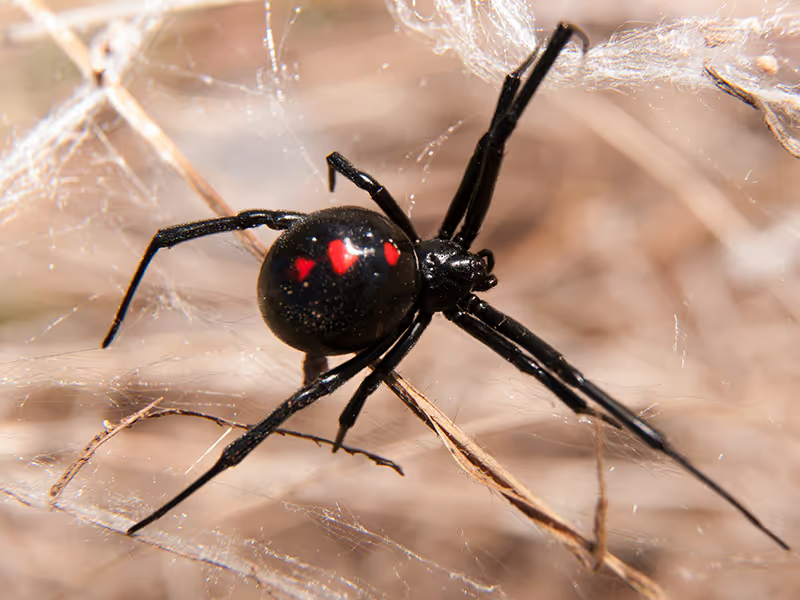Black widow spiders are easy to recognize thanks to their glossy black bodies and the iconic red hourglass marking on the underside of the female’s abdomen. Despite their big reputation, they’re not large spiders. A full-grown female’s body is about ½ inch long, and her legs add a bit more, making her about the size of a quarter overall.
Male black widows are much smaller, about half the size of females. They typically measure between ¼ inches and ¾ inches, including their legs. Males are brown or gray with red, orange, or white spots or markings, giving them a very different appearance from the females.
Juvenile black widows start off white, orange, or brown. As they grow, they darken and develop red, orange, or yellow markings within white and black patterns.
While males and juveniles are not dangerous, identifying them can help alert you to the possible presence of females nearby.

Black widows are predators that feed on various insects, arthropods, and other arachnids. Their diet includes flies, ants, mosquitoes, caterpillars, beetles, grasshoppers, millipedes, and even scorpions.
Yes. Black widow spiders spin irregular, tangled webs made from strong silk to trap their prey. Within the web, the female typically builds a retreat, a funnel-like shelter where she hides and protects herself from predators.
Black widows prefer dark, quiet, and undisturbed areas close to the ground. You’re most likely to find their webs in these spots:
If they make it indoors, they’ll head for secluded, dark areas like basements, utility closets, or storage boxes.
Black widow venom is potent, and bites can cause serious symptoms, but they are rarely fatal. In fact, the last recorded death from a black widow bite reported by the American Association of Poison Control Centers was in 1983.
Their venom is neurotoxic, meaning it affects the nervous system. While deaths are rare, bites can be painful and trigger a range of systemic symptoms. Fortunately, black widows are shy by nature and usually bite only in self-defense.
It’s difficult to confirm a black widow bite based on appearance alone. You’re more likely to identify one by how symptoms develop. Bites often start with a sharp pinprick or stinging sensation, followed by redness and swelling. Within 15 minutes to an hour, you may begin to feel muscle pain near the bite that spreads outward.
Symptoms that may develop within 6–12 hours include:
If you suspect a black widow bite, seek medical attention right away. Don’t wait for symptoms to worsen.
Black widow spiders are drawn to areas with plenty of food. If your yard has lots of insect activity, like flies, cockroaches, or mosquitoes, you may also attract black widows. Moisture sources and clutter, such as brush, wood, or rock piles, also provide the shelter they seek.
Reducing insect populations and limiting hiding spots is key to keeping them away.
For help getting rid of black widow spiders, contact Harbor Pest Control. Serving San Diego since 1948, our locally owned and family-operated pest control company will inspect your property, identify the issue, and take the necessary steps to eliminate the spiders.
Yes. Here are some tips to help keep black widow spiders out of your yard and home:
For added protection, consider a year-round home pest control plan. Regular treatments from a licensed pest professional will help keep pests and the spiders that hunt them away from your home.





Helpful Tips & Info